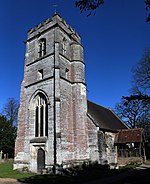Lapworth

Lapworth is a village and civil parish in Warwickshire, England, which had a population of 2,100 according to the 2001 census; this had fallen to 1,828 at the 2011 Census. It lies seven miles (11 km) south of Solihull and ten miles (16 km) northwest of Warwick, and incorporates the hamlet of Kingswood. Lapworth boasts a historic church, the Church of St Mary the Virgin, a chapel. Two National Trust sites are nearby: Baddesley Clinton, a medieval moated manor house and garden located in the village of Baddesley Clinton; and Packwood House, a Tudor manor house and yew garden with over 100 trees in Packwood. The church is a building largely of the 13th and 14th centuries. It includes several unusual features: the steeple is connected by a passage to the north aisle and is built sheer with a projecting stair; the clerestory has square-headed windows; and there is a two-storey annex at the west end. In the church the Portland memorial to Florence Bradshaw was the work of Eric Gill and was installed in 1928. It is a Virgin and Child carved in low relief. The village is a popular area for cuisine, with three pubs "The Boot", "The Navigation" and "The Punch Bowl". At Kingswood Junction, the Grand Union Canal joins the Stratford-upon-Avon Canal, which has a major flight of locks. Catesby Lane in Lapworth is named after William Catesby (the great grandfather of Robert Catesby of Gunpowder Plot fame), whose family had been settled at Bushwood Hall, in the neighbouring parish of Bushwood, since the 14th century. The manor house was probably at Lapworth Hall, today Ireland's Farm, and in the 17th and 18th centuries the house of the Mander family of Wolverhampton. The furniture designer and maker Hugh Birkett worked from the late 1940s until 1966 in the garage at his parents' home in Lapworth. Examples of his work can be seen at Cheltenham Museum.
Excerpt from the Wikipedia article Lapworth (License: CC BY-SA 3.0, Authors, Images).Lapworth
Church Lane,
Geographical coordinates (GPS) Address Nearby Places Show on map
Geographical coordinates (GPS)
| Latitude | Longitude |
|---|---|
| N 52.338 ° | E -1.762 ° |
Address
Church Lane
B94 5NX
England, United Kingdom
Open on Google Maps









